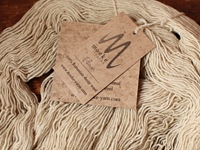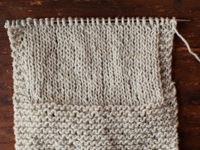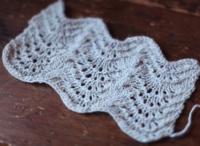|
Yarn Profile: Elena from Moeke Yarns First Impressions
Not too long afterwards, a package arrived from the Netherlands. Inside, my very own skeins to swatch. The yarn, called Elena, comes from the year-old Moeke Yarns. While the yarn was shipped from the Netherlands, its country of origin is most distinctly Romania. Moeke was founded by Ioana van Deurzen and her brother Radu. They grew up in Communist Romania and were cared for by their maternal grandparents in a small country village. They grew up, politics changed, the grandparents passed away, and eventually Ioana moved to the Netherlands to pursue a PhD in Sociology. But last year she returned to Romania to visit her parents, now living in her grandparents' home. There she discovered a bag of her grandmother's handspun yarn. Amidst the flood of memories came a realization: Romania has its own sheep, and it has a few spinning mills. What if she and her brother (who still lives in Romania) started their own line of pure Romanian wool yarns? That was a year ago. Today, Ioana and Radu's company is off to a good start. They offer two yarn bases: Elena, made from what they call "traditional" Romanian wool; and Stela, made from a blend of Romanian sheep breeds. For this review, I chose Elena. Knitting Up Both Elena and Stela are singles yarns consisting of one strand of continuously spun fiber. Singles are the least balanced of all yarns for the simple reason that they have no companion against whom they can release any excess twist. They also can produce a slightly wobbly stockinette because any variation in fiber thickness is immediately visible in the finished fabric. Generally speaking, they're used for an artisan effect. Ioana had cleverly preserved space (and postage costs) by shipping the skeins flat and untwisted. The fibers were so crispy and distinct that they didn't tangle in transit. Winding my skein was a breeze. So, too, was the knitting of this yarn. I decided to try knitting with a pair of pointy-tipped Addi Turbo Rockets to see how much of a snagger this yarn was. Turns out, the fibers are so happy in their twist that they never snagged—even when I was knitting by touch alone. Elena is an easy, pleasant knit. Occasional thick/thin areas notwithstanding, the yarn's roundedness produces wonderful knits and purls. Garter was a pleasure, and a modified feather-and-fan motif positively sculptural. The same crisp, distinct qualities that kept the yarn from tangling in transit also held each stitch firmly in place, even when dropped from the needle. Blocking / Washing I held the wash bowl up to the light and could see a milky tan color, always a good sign. This told me we might be in for a surprise—or at least a pleasant treat—once that swatch was rinsed and had time to dry. With whatever caused that color out of the way, the fabric can be lighter and loftier. In this case, the swatches never lost their crunchiness, but they did soften and gently bloom into a more cohesive, "finished"-looking fabric. Wearing The touch of Elena is definitely on the crisp, crunchy side. I probably wouldn't use it for a scarf or a thin sweater meant to be worn with little underneath. Likewise, the singles construction pretty much eliminates it from the sock-yarn category, unless you really know what you're doing and can modify your stitches to mitigate the risks. (I wrote a whole book about doing this, if you're curious to learn more.) I only warn you away from socks because of this yarn's (relatively vulnerable) single-ply construction. The fibers themselves are as sturdy as they come, and they're reluctant to slip from one-another's grasp under friction. It took significant thrashing before my swatches began to show signs of surrender. This yarn is a lovely fighter. Conclusion Knowing these two things about me, and considering the fact that you can get a skein of Elena for under $10, I think you won't be surprised when I suggest, quite wholeheartedly, that you give this one a swatch. |
Yarn Name
Elena
Manufacturer
Moeke Yarns
Fiber content
100% Romanian wool
Gauge
20 stitches per 4 inches (10cm) on US4 (3.5mm) needles
Average retail price
$9.32-$10.48/skein depending on size
Weight/yardage per skein
Varies. My review skein was 80g / 264 yards (288m)
Country of origin
Romania
Manufacturer's suggested wash method
Hand wash. Dry flat.
Review date
2/19/2015
Color used in review
Natural
Wholesale distributor in the U.S.
Moeke Yarns
Source of review yarn
Purchased from Moeke on Etsy |
Copyright © 2000-2016 Clara H. Parkes
All rights reserved. Permission to reproduce is required.
All rights reserved. Permission to reproduce is required.



